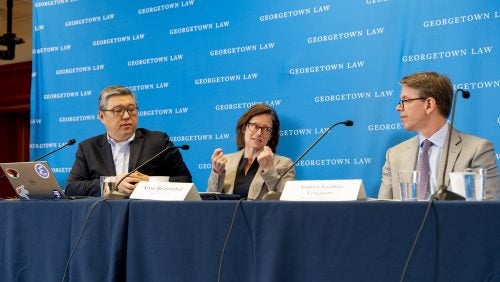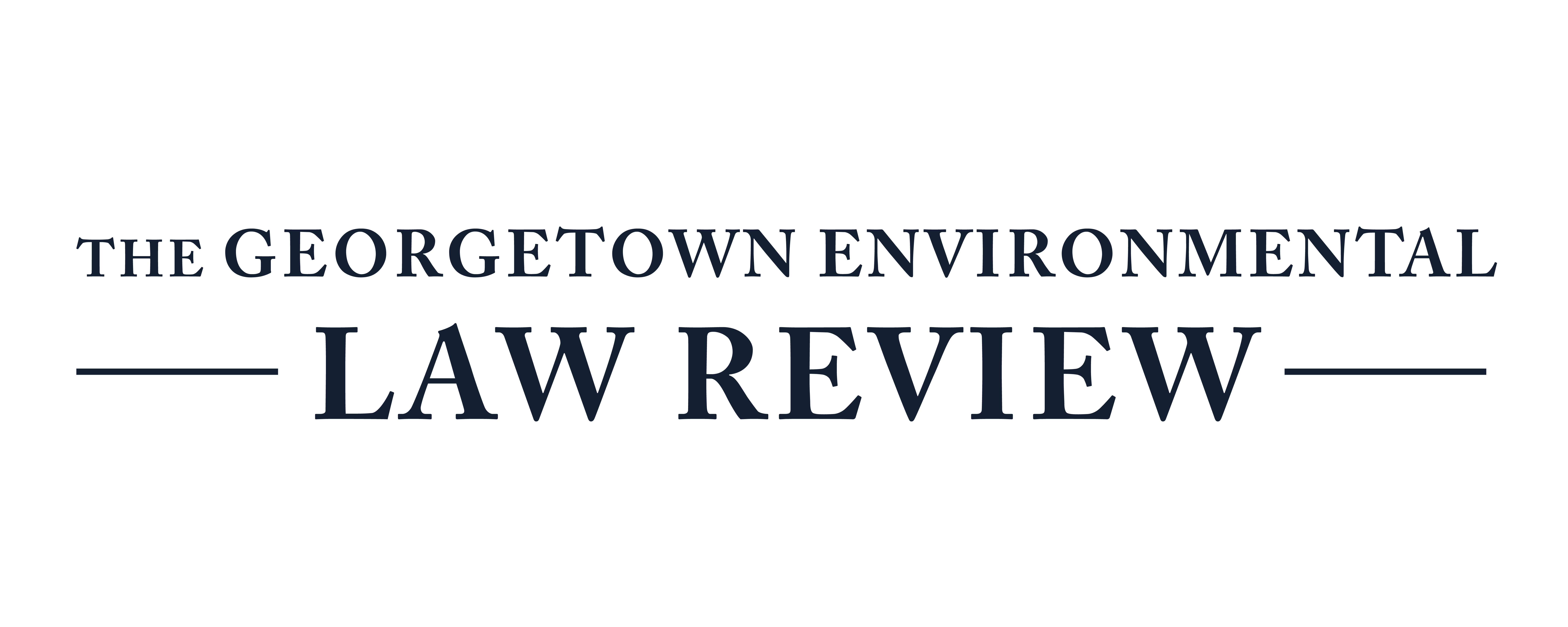Artificial Intelligence and Environmental Compliance and Enforcement
September 16, 2025 by Soniya Nahata

Panel of 4th Amendment experts including Professors; Paul Ohm (Georgetown Law), Alyse Bertenthal (Wake Forest Law), and Andrew Ferguson (George Washington University Law). Photo by: Laurie DeWitt/Pure Light Images
The report covers key thoughts, discussions, and findings from the 2025 Georgetown AI and Environmental Compliance and Enforcement Symposium in pursuit of unpacking the technical and legal nexus between AI and environmental compliance and enforcement.
Introduction:
As artificial intelligence rapidly transforms how we detect, interpret, and respond to environmental violations, its relationship with enforcement and justice is coming into sharper focus. The 2025 AI and Environmental Compliance and Enforcement Symposium – introduced by one of its key organizers, Professor Lydia Slobodian, Director of the Georgetown Environmental Law and Policy Program – brought together legal scholars, technologists, and advocates to explore how emerging AI tools can help promote accountability, transparency, and equity. At the heart of the conversation was a hopeful yet cautious theme: democratization. If governed responsibly, AI could shift power from centralized actors to frontline communities and non-state actors, enabling earlier, fairer, and more widespread enforcement.
Panel 1: Will AI Revolutionize Environmental Compliance and Enforcement – AI Tools for Enforcement and Early Action
“A real opening into the window of the future.” – Dean Lee Paddock (associate dean for environmental law studies at George Washington Law)
The first panel, moderated by Dean Paddock, composed of technologists and enforcement researchers who introduced cutting-edge uses of AI-powered satellite and geospatial tools to detect environmental harm, particularly in hard-to-reach areas. Speakers emphasized not only the capabilities of these tools, but their accessibility and potential to “reduce the gap and create space for all sorts of people to take advantage of these AI-powered tools.”
Steve Brumby (Founder, Impact Observatory) described how advances over the last decade have made it possible to supply large geospatial datasets to both commercial and public actors. He emphasized that “AI has developed in such a way that there is a real opportunity to democratize the technology further,” allowing “a level playing field of facts that everyone can use for decision making.” Brumby pointed out that tools combining satellite imagery, deep learning, and natural language processing now enable users, regardless of technical background, to generate accurate, timestamped environmental maps that could “hold up in a legal setting.” He stressed that these technologies enable easier access to middle- and lower-income countries, as well as indigenous peoples, local communities, and non-profits.
One breakthrough Brumby highlighted was the development of natural language interfaces that allow non-technical users to “turn satellite imagery into maps,” automating a process that once required technical expertise and proprietary systems. This leads to a dynamic where concerned individuals can act in time; where he highlights system efficiency in noting that “early detection is much better than having to go sue someone after the devastation has occurred.”
Govinda Terra (IBAMA, Brazil) presented on the use of AI to combat illegal deforestation in the Amazon, where enforcement capacity is often limited. He noted that deforestation accounts for over “40% of Brazil’s emissions,” and that enforcement effectiveness relies on increasing the perceived risk for violators. Terra described the development of predictive maps that use machine learning and satellite data to forecast high-risk deforestation zones up to fifteen days in advance. These maps enable targeted action, thereby improving deterrence and resource allocation. Drawing from criminology, he explained that “if the economic advantage is higher than the fine, it motivates the infraction,” so AI-enhanced monitoring raises both the risk and the operational cost for offenders.
He emphasized that celerity and certainty of punishment are crucial to deterring environmental crime. By enabling “faster sanctioning processes” and better targeting of inspections, AI tools are helping to shift these dynamics. He also referenced the use of AI to track stolen forest assets, such as cattle, further disrupting illegal supply chains and increasing the perceived consequences of noncompliance.
Susannah Dibble (INECE) emphasized the real-world application of these tools in remote and under-monitored areas, noting efforts made to track illegal tire dumping. She described INECE’s mission to support capacity-building and information sharing among inspectors and enforcement professionals, especially in regions lacking access to traditional resources. Dibble also flagged key questions moving forward: “What are the privacy and environmental concerns that we should be thinking about when developing more tools?”
This panel closed on an optimistic note with Brumby’s assertion that “this is a moment in which everyone has access to information that was, in the past, only available to the richest countries,” highlighting the shift toward democratized enforcement infrastructure.
Panel 2: Surveillance, Privacy, and the Constitution – AI and the Fourth Amendment
While the first panel offered hope for more equitable and effective enforcement through AI, the second panel turned its focus to the constitutional and ethical risks of widescale monitoring. Moderated by Professor Paul Ohm, the session tackled the Fourth Amendment implications of deploying AI for environmental compliance, especially as state and non-state actors adopt increasingly sophisticated surveillance tools.
Ohm opened with the question: “Is it a [Fourth Amendment] search to look into a forest from a satellite? Is it an unreasonable search to use AI to glean information from that?” These questions framed a deep discussion on how traditional legal frameworks are grappling with new technological capabilities.
Sarah Myers West (AI Now Institute) challenged the assumption that environmental AI tools are inherently trustworthy or neutral. She pointed out that “from a compliance perspective, how do you validate what you are seeing from the system as true?,” especially when many of these tools originate as “commercialized products” not subject to government mandate or oversight. Myers warned of a “veneer of inevitability” in AI rhetoric, especially when it conceals the industry’s ties to fossil fuel extraction and surveillance capitalism. “It’s not for nothing that these smaller bottom-up projects look very different,” she noted, calling for more support for community-led technologies that reflect public values.
Professor Alyse Bertenthal (Wake Forest University) brought a grounded perspective from her work with communities monitoring local pollution. She highlighted that while AI can help “translate lived experiences” into language recognized by regulators, it can also reproduce power asymmetries. She stressed that “access to information,” “analysis tools,” and “communication” must go hand-in-hand, noting that “the most promising element of democratization is access to analysis.” Still, environmental AI must be designed with a clear understanding of the risks of surveillance and overreach.
Andrew Ferguson (American University) warned of the “danger of capturing everything else” when satellites and AI are used to track public activity. While traditional Fourth Amendment doctrine might not classify satellite imagery as a search, Ferguson referring to two cases which suggested that people lacked a right to privacy when traveling on public streets, argued that “whatever the baseline was in 1976 and 1983 is not today, and we need to start anew to understand the harms.” He pointed to the Court’s evolving recognition, particularly in Carpenter v. United States, that long-term surveillance reveals sensitive patterns requiring heightened legal protection.
The panel also examined the role of market dynamics. Myers raised concerns about how “citizen-minded nonprofits trying to build these tools for the ‘good guys’” often find themselves outpaced or acquired by large tech firms. Referencing the agritech sector, she noted that while tools may be marketed as climate-positive (e.g. measuring carbon emissions), they may ultimately “encourage practices that serve corporate interests” under the guise of sustainability.
As Bertenthal noted, “We need more power to further this, and where do we draw the line?” The panel concluded that legal doctrine must evolve to reflect both the inference-based nature of AI and the specific privacy risks posed by environmental surveillance. Myers closed with a reminder that “AI is being used in places where people are not able to give consent,” and that environmental advocates must remain vigilant in preserving rights even in service of worthy goals.
Conclusion: Toward a Just Environmental AI Future
Across both panels, speakers stressed that the development and deployment of AI in environmental enforcement is not just a technical issue, it is a political, legal, and ethical one. The promise of AI lies in its ability to democratize information, improve compliance, and support earlier intervention. But these benefits must be balanced against the risks of overreach, inequity, and unchecked surveillance.
As Professor Ohm reflected, “This is a panel about inference. We have this data, and now we can come to a conclusion about it.” But inferences, especially when automated, raise legal and normative questions that remain unresolved.
To move forward, environmental lawyers, technologists, and policymakers must ask:
Who builds these tools? Who governs them? Who benefits? And who might be harmed?
The symposium made it clear that the answers to these questions will shape not only the success of environmental AI, but the future of environmental justice itself.

